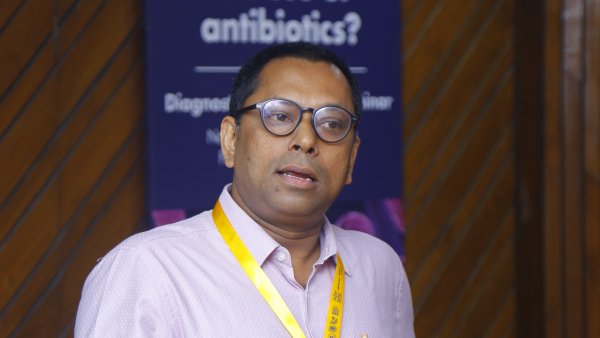Our innovators are taking the AMR fight to the front line
11 Sep 2019
In 2008, the credit crunch turned the world on its head. Repercussions were felt across the globe as long established institutions collapsed, national governments changed, and individuals bore the brunt of austerity and economic contraction. The impact of the financial crisis was so huge that even today, 11 years on, its effects can still be seen and felt. However, the global response to contain the damage, to protect economies, to mobilise resources at a colossal scale to prevent a disaster becoming a calamity, shows that mobilisation on a global scale in the face of disaster is possible, if the collective will to do so is strong enough.
We are in the midst of creating a disaster of another kind, one that has just as equal a chance at becoming calamitous. The twentieth century was transformative for modern medicine thanks to the discovery of antibiotics. Once deadly bacteria could be treated with a simple course of tablets. But, overuse of antibiotics is now ubiquitous, with unnecessary dispensing and reliance on broad-spectrum treatments all driving antimicrobial resistance. Whilst antibiotics have saved countless lives, bacteria are evolving resistance to the majority of those available today. With 10 million people now expected to die globally by 2050 because of drug-resistant superbugs, misuse of antibiotics has caused a crisis that requires a globally mobilised response.
At our recent roundtable event in New Delhi, Dr Sundeep Sarin (Department of Biotechnology, Government of India), drew just this comparison when addressing the challenges posed by superbugs. We partnered with the Government of India’s Biotechnology Industry Research Assistance Council (BIRAC) to discuss with innovators, clinicians, scientists and government representatives what needs to happen to accelerate innovation in point-of-care diagnostic testing in order to conserve antibiotics for future generations.

BIRAC is playing a vital role in supporting Indian innovators and SMEs who are developing diagnostic tests through specialised Longitude Prize grants and other grant funding. With BIRAC support and technical assistance, Indian start-ups and SMEs are in pursuit of the £8 million Longitude Prize. Antibiotic resistance is a global challenge, and is an acute problem in India. New rapid diagnostic tests will conserve antibiotics by reducing overuse and making their use more targeted.
Associate Professor Vikas Manchanda (Maulana Azad Medical College) cited numerous studies showing that half of all patients who see a physician are given antibiotics; in the USA 30% of the prescriptions are wholly unnecessary. Over-prescribing is a response to reduce risk, to treat the “just in case”, or to mollify a demanding patient. In a primary care setting away from labs and specialised facilities, it can often be the responsible option for a physician. This however is a driver of AMR. Rapid diagnostic tests that can confirm the need for an antibiotic and identify which one to prescribe are key to preserving their use for future generations.
AMR has huge consequences. Senior Consultant Sanjay Bhattacharya (Department of Microbiology, Tata Medical Centre, Kolkata) explained that superbugs mean more patients need intensive care and hospital stays are often longer.
Cancer survival rate may be measured in months and years, when a patient develops a serious resistant infection, this can collapse to mere hours if the right antibiotic is not identified. With medical bills for some patients meaning selling their homes, the negative impacts of AMR are not only medical.
– Dr Sanjay Bhattacharya, Tata Medical Centre

Dr Sudeshna Adak, CEO of OmiX, one of the teams developing a rapid diagnostic test, expanded on the challenge facing medical professionals and patients in India. She raised the example of a rural village, 20 km outside of the nearest major city, served only by slow-running buses in the morning and the evening. In the evening and at weekends, the local school becomes the local hospital. Classrooms become wards, a pharmacy and a simple lab.
After waiting until the evening for the clinic to open, a patient may present with symptoms of a serious infection, in which case they must be referred to the hospital in the city. The patient travels the long and winding journey to the city to take a test then returns to the village. It can take three days before the test results are ready to collect, requiring another long and winding journey to the hospital and back in order to identify the infection and recommend an appropriate antibiotic. It’s little wonder a doctor might choose a broad-spectrum antibiotic treatment instead.
Presently, standard diagnostic tests use reagents that must be kept cool and require refrigeration – often only available in labs at central hospitals. With this, and the convoluted patient journey in mind, OmiX has developed a rapid test which uses molecular technology to read the bacterial DNA in samples to identify infections in 90 minutes with minimal skill and infrastructure. A patient can arrive at the clinic, be tested immediately for bloodstream infections, urinary tract infections and respiratory tract infections, using lab equipment that works with reagents which can be stored at room temperature. The benefits to the patient and clinicians are clear: rapid, accurate results available where care is delivered.
In order to avoid letting a patient’s infection get out of control, we need tests that will quickly tell us which antibiotics will work; that way people get the antibiotics that can cure them first time around.
– Professor Till Bachmann, The University of Edinburgh
This pursuit of rapid and accurate cost-effective diagnostics that can be used with minimal training is the goal of the Longitude Prize. Thanks to teams of innovators, not only in India, but across the world, we are getting closer to seeing the widespread availability of rapid diagnostic products that help doctors and patients, and contribute to a future where antibiotics are effective. It is a global fight and requires a global effort.
